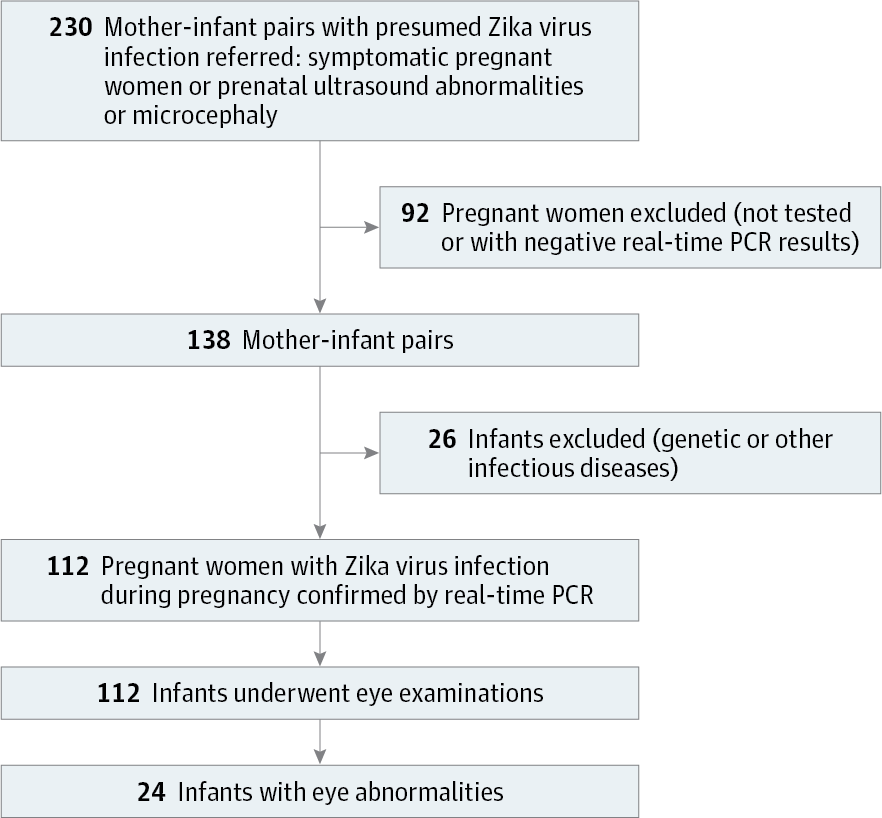当前位置:
X-MOL 学术
›
JAMA Pediatr.
›
论文详情
Our official English website, www.x-mol.net, welcomes your feedback! (Note: you will need to create a separate account there.)
Screening Criteria for Ophthalmic Manifestations of Congenital Zika Virus Infection
JAMA Pediatrics ( IF 26.1 ) Pub Date : 2017-09-01 , DOI: 10.1001/jamapediatrics.2017.1474 Andrea A. Zin 1 , Irena Tsui 2 , Julia Rossetto 3 , Zilton Vasconcelos 1 , Kristina Adachi 4 , Stephanie Valderramos 5 , Umme-Aiman Halai 2 , Marcos Vinicius da Silva Pone 6 , Sheila Moura Pone 6 , Joel Carlos Barros Silveira Filho 7 , Mitsue S. Aibe 6 , Ana Carolina C. da Costa 1 , Olivia A. Zin 8 , Rubens Belfort 9 , Patricia Brasil 10 , Karin Nielsen-Saines 4 , Maria Elisabeth Lopes Moreira 1
JAMA Pediatrics ( IF 26.1 ) Pub Date : 2017-09-01 , DOI: 10.1001/jamapediatrics.2017.1474 Andrea A. Zin 1 , Irena Tsui 2 , Julia Rossetto 3 , Zilton Vasconcelos 1 , Kristina Adachi 4 , Stephanie Valderramos 5 , Umme-Aiman Halai 2 , Marcos Vinicius da Silva Pone 6 , Sheila Moura Pone 6 , Joel Carlos Barros Silveira Filho 7 , Mitsue S. Aibe 6 , Ana Carolina C. da Costa 1 , Olivia A. Zin 8 , Rubens Belfort 9 , Patricia Brasil 10 , Karin Nielsen-Saines 4 , Maria Elisabeth Lopes Moreira 1
Affiliation

|
Importance Current guidelines recommend screening eye examinations for infants with microcephaly or laboratory-confirmed Zika virus infection but not for all infants potentially exposed to Zika virus in utero. Objective To evaluate eye findings in a cohort of infants whose mothers had polymerase chain reaction–confirmed Zika virus infection during pregnancy. Design, Setting, and Participants In this descriptive case series performed from January 2 through October 30, 2016, infants were examined from birth to 1 year of age by a multidisciplinary medical team, including a pediatric ophthalmologist, from Fernandes Figueira Institute, a Ministry of Health referral center for high-risk pregnancies and infectious diseases in children in Rio de Janeiro, Brazil. Participants Mother-infant pairs from Rio de Janeiro, Brazil, who presented with suspected Zika virus infection during pregnancy were referred to our institution and had serum, urine, amniotic fluid, or placenta samples tested by real-time polymerase chain reaction for Zika virus. Main Outcomes and Measures Description of eye findings, presence of microcephaly or other central nervous system abnormalities, and timing of infection in infants with confirmed Zika virus during pregnancy. Eye abnormalities were correlated with central nervous system findings, microcephaly, and the timing of maternal infection. Results Of the 112 with polymerase chain reaction–confirmed Zika virus infection in maternal specimens, 24 infants (21.4%) examined had eye abnormalities (median age at first eye examination, 31 days; range, 0-305 days). Ten infants (41.7%) with eye abnormalities did not have microcephaly, and 8 (33.3%) did not have any central nervous system findings. Fourteen infants with eye abnormalities (58.3%) were born to women infected in the first trimester, 8 (33.3%) in the second trimester, and 2 (8.3%) in the third trimester. Optic nerve and retinal abnormalities were the most frequent findings. Eye abnormalities were statistically associated with microcephaly (odds ratio [OR], 19.1; 95% CI, 6.0-61.0), other central nervous system abnormalities (OR, 4.3; 95% CI, 1.6-11.2), arthrogryposis (OR, 29.0; 95% CI, 3.3-255.8), and maternal trimester of infection (first trimester OR, 5.1; 95% CI, 1.9-13.2; second trimester OR, 0.5; 95% CI, 0.2-1.2; and third trimester OR, 0.3; 95% CI, 0.1-1.2). Conclusions and Relevance Eye abnormalities may be the only initial finding in congenital Zika virus infection. All infants with potential maternal Zika virus exposure at any time during pregnancy should undergo screening eye examinations regardless of the presence or absence of central nervous system abnormalities.
中文翻译:

先天性寨卡病毒感染眼科表现的筛选标准
重要性 目前的指南建议对患有小头畸形或实验室确诊寨卡病毒感染的婴儿进行眼部检查,但并非所有可能在子宫内接触寨卡病毒的婴儿。目的 评估母亲在怀孕期间确诊感染寨卡病毒的一组婴儿的眼部表现。设计、设置和参与者 在 2016 年 1 月 2 日至 10 月 30 日进行的这个描述性病例系列中,婴儿从出生到 1 岁由来自 Fernandes Figueira 研究所的多学科医疗团队(包括儿科眼科医生)进行检查,巴西里约热内卢的儿童高危妊娠和传染病健康转诊中心。参与者来自巴西里约热内卢的母婴对,那些在怀孕期间出现疑似寨卡病毒感染的人被转诊到我们的机构,并通过实时聚合酶链反应对寨卡病毒进行了血清、尿液、羊水或胎盘样本检测。主要结果和措施 描述眼部发现、小头畸形或其他中枢神经系统异常的存在,以及妊娠期间确诊寨卡病毒婴儿的感染时间。眼睛异常与中枢神经系统发现、小头畸形和母体感染的时间有关。结果 在 112 名母体标本中经聚合酶链反应证实感染寨卡病毒的婴儿中,24 名婴儿 (21.4%) 接受检查有眼部异常(首次眼科检查的中位年龄为 31 天;范围为 0-305 天)。有眼部异常的 10 名婴儿 (41.7%) 没有小头畸形,8 名 (33. 3%) 没有任何中枢神经系统发现。14 名眼部异常婴儿 (58.3%) 出生于妊娠早期感染的女性,8 名 (33.3%) 出生于妊娠中期,2 名 (8.3%) 出生于妊娠晚期。视神经和视网膜异常是最常见的发现。眼部异常与小头畸形(比值比 [OR],19.1;95% CI,6.0-61.0)、其他中枢神经系统异常(OR,4.3;95% CI,1.6-11.2)、关节弯曲(OR,29.0; 95% CI,3.3-255.8)和孕期感染(孕早期 OR,5.1;95% CI,1.9-13.2;孕中期 OR,0.5;95% CI,0.2-1.2;孕晚期 OR,0.3; 95% 置信区间,0.1-1.2)。结论和相关性 眼部异常可能是先天性寨卡病毒感染的唯一初步发现。
更新日期:2017-09-01
中文翻译:

先天性寨卡病毒感染眼科表现的筛选标准
重要性 目前的指南建议对患有小头畸形或实验室确诊寨卡病毒感染的婴儿进行眼部检查,但并非所有可能在子宫内接触寨卡病毒的婴儿。目的 评估母亲在怀孕期间确诊感染寨卡病毒的一组婴儿的眼部表现。设计、设置和参与者 在 2016 年 1 月 2 日至 10 月 30 日进行的这个描述性病例系列中,婴儿从出生到 1 岁由来自 Fernandes Figueira 研究所的多学科医疗团队(包括儿科眼科医生)进行检查,巴西里约热内卢的儿童高危妊娠和传染病健康转诊中心。参与者来自巴西里约热内卢的母婴对,那些在怀孕期间出现疑似寨卡病毒感染的人被转诊到我们的机构,并通过实时聚合酶链反应对寨卡病毒进行了血清、尿液、羊水或胎盘样本检测。主要结果和措施 描述眼部发现、小头畸形或其他中枢神经系统异常的存在,以及妊娠期间确诊寨卡病毒婴儿的感染时间。眼睛异常与中枢神经系统发现、小头畸形和母体感染的时间有关。结果 在 112 名母体标本中经聚合酶链反应证实感染寨卡病毒的婴儿中,24 名婴儿 (21.4%) 接受检查有眼部异常(首次眼科检查的中位年龄为 31 天;范围为 0-305 天)。有眼部异常的 10 名婴儿 (41.7%) 没有小头畸形,8 名 (33. 3%) 没有任何中枢神经系统发现。14 名眼部异常婴儿 (58.3%) 出生于妊娠早期感染的女性,8 名 (33.3%) 出生于妊娠中期,2 名 (8.3%) 出生于妊娠晚期。视神经和视网膜异常是最常见的发现。眼部异常与小头畸形(比值比 [OR],19.1;95% CI,6.0-61.0)、其他中枢神经系统异常(OR,4.3;95% CI,1.6-11.2)、关节弯曲(OR,29.0; 95% CI,3.3-255.8)和孕期感染(孕早期 OR,5.1;95% CI,1.9-13.2;孕中期 OR,0.5;95% CI,0.2-1.2;孕晚期 OR,0.3; 95% 置信区间,0.1-1.2)。结论和相关性 眼部异常可能是先天性寨卡病毒感染的唯一初步发现。



























 京公网安备 11010802027423号
京公网安备 11010802027423号